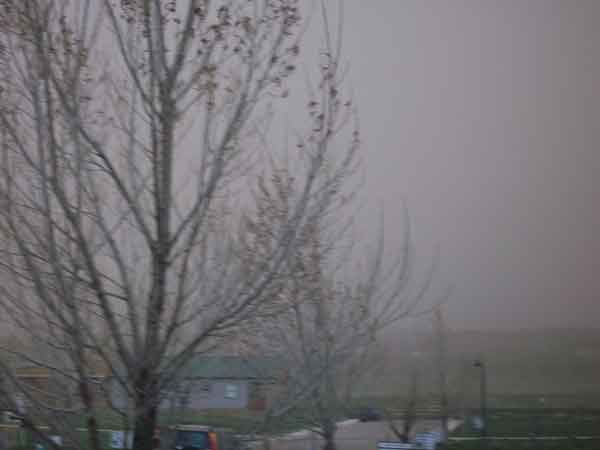
Mountains, usually visible, are obscured by dust. Photo by Ben Williams
Recent dust storms from strong winds have had the communities of Norwood, Telluride and Mountain Village concerned about future contamination with radionuclides should uranium development in the Paradox valley ramp up.
Winds measuring consistently above 40 mph have mobilized large quantities of dust from the west end of San Miguel County, bringing sands all the way from Utah. Paradox valley, the proposed site for a new uranium mill, is due west of the resort communities of Telluride and Mountain Village, and the ranching town of Norwood.
The dust storms, which occurred over two days at the end of March and early May, brought thick quantities of red dust up into the mountains, obscuring the sky and reducing visibility.
“It was like being in a red fog,” said one Norwood resident. “I couldn’t even see Lone Cone [mountain].”
The dust filled the sky, covered cars and homes, and settled visibly on the slopes around Telluride. It was an eerie portent, a bloody sunset and doom-like sky.
Each spring strong winds race up Wright’s mesa, heading in from the desert. A strong differential is formed by the heat in the low-lying desert areas around Moab and the four corners, and the cool mountain air at elevation. Each year, winds roll in from the west. But this amount of dust was unusual.
“Frankly, I’m worried that once the mining and milling operations crank up in Paradox, this dust will glow in the dark!” Joked a Telluride worker. "Hey, maybe we can go night skiing!"
One resident of Norwood, a recent father, said he would leave the area before construction of the mill began, if the final permits get approved.
“I won’t expose my son to anything like that,” he said, even as property values fall under the faltering economy. "I'll just sell, and get the hell out."
Aside from containing potentially deadly alpha-emitters, the dust has a known impact on the local economy of Telluride and Mountain Village. It speeds snow melt.
As the San Juan Mountains lie at the tip of the watershed, any contaminants borne by the wind will end up in waterways and flow downstream. Ranchers who use irrigation will spray them on crops. Meanwhile, livestock will ingest them in the wind and grasses. This is akin to a secondary pulse of exposure. Exposure repeats as the particles move through the biosphere. As agricultural products are sent to market, and distributed nationally, tertiary pulses become possible.
Energy Fuels is confident it can mitigate fugitive dust. An enormous amount of water will be used to spray down drop-off and tailing sites. Keeping the areas wet will reduce dust. However, fans in area mines that vent mining shafts regularly spray out small dust particles. These mines will kick up again if the mill gets approved.
Nevertheless the perception is there: The dust seemed portentous of the region's uncertain future. In coffee shops and on street corners subdued tones and watchful eyes bespoke the common fear. What does this mean in two years if uranium development increases? Why aren't plume studies a necessary part of any application to develop radioactive resources? Do the regulations imposed by the Colorado Department of Health and the Environment address these concerns? The questions went on, but were swallowed by the wind.





No comments:
Post a Comment